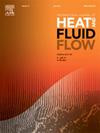锂电池热管理系统损伤单元检测研究
IF 2.6
3区 工程技术
Q2 ENGINEERING, MECHANICAL
International Journal of Heat and Fluid Flow
Pub Date : 2025-04-23
DOI:10.1016/j.ijheatfluidflow.2025.109857
引用次数: 0
摘要
目前,电动汽车行业正在经历大幅增长,由于其使用清洁能源且对环境影响较小,因此广受消费者欢迎。电动汽车的电池是制约电动汽车发展的关键因素,其温度是极大影响电池性能的主要部件。本文研究了锂电池组的结构参数,以提高其耐用性。通过使用样本优化方法,确定了理想的结构参数,以确保改善冷却效果。随后,利用不同的发热率模拟了三种类型的电池损坏。通过布置温度传感器并分析三种损坏情况下传感器的反馈值,可以得出使用较少温度传感器就能确定电池组中某一电池损坏位置和损坏程度的规则。最后,通过对反馈值进行二次函数拟合,得到了精确确定损坏程度的方程。本文提出的损坏单元检测方案可广泛应用于提高电池系统的安全性,减少电池过热引起的火灾和爆炸等危险的发生。本文章由计算机程序翻译,如有差异,请以英文原文为准。
Research on damaged unit detection of lithium battery thermal management system
Currently, the electric car sector is experiencing significant growth and is widely popular among the consumers due to its utilization of clean energy and little impact on the environment. The battery of electric vehicles is a crucial constraint on the advancement of the electric vehicles, with its temperature being the primary component that greatly affects the battery’s performance. This article examines the structural parameters of lithium battery packs in order to enhance their durability. By utilizing a sample optimization method, the ideal structural parameters are determined to ensure an improved cooling effect. Subsequently, three types of battery damage were simulated using different heat generation rates. By arranging the temperature sensors and analyzing the feedback values of the sensors under three types of damaged conditions, a rule that determining the damaged location and damaged degree of a certain battery in the battery pack can be obtained by using fewer temperature sensors. Finally, by fitting the feedback values as a quadratic function, an equation accurately determining the degree of damage is obtained. The damaged unit detection scheme proposed in this article can be widely applied to improve the safety of battery systems and reduce the occurrence of hazards such as fire and explosion caused by overheating of the batteries.
求助全文
通过发布文献求助,成功后即可免费获取论文全文。
去求助
来源期刊

International Journal of Heat and Fluid Flow
工程技术-工程:机械
CiteScore
5.00
自引率
7.70%
发文量
131
审稿时长
33 days
期刊介绍:
The International Journal of Heat and Fluid Flow welcomes high-quality original contributions on experimental, computational, and physical aspects of convective heat transfer and fluid dynamics relevant to engineering or the environment, including multiphase and microscale flows.
Papers reporting the application of these disciplines to design and development, with emphasis on new technological fields, are also welcomed. Some of these new fields include microscale electronic and mechanical systems; medical and biological systems; and thermal and flow control in both the internal and external environment.
 求助内容:
求助内容: 应助结果提醒方式:
应助结果提醒方式:


